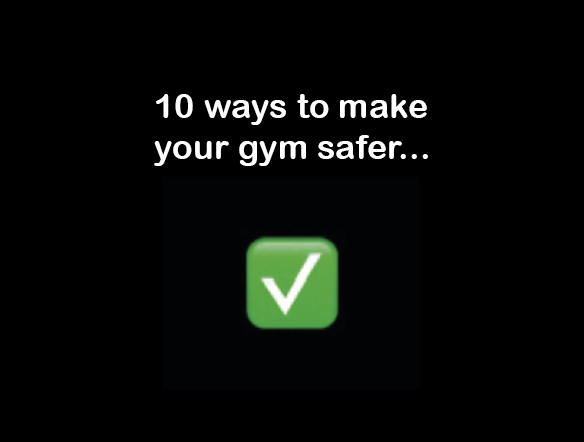10 Ways to Make your Gym Safer

Here are our top 10 tips for a safer gym:
***
1. Remove j-cups from the rig when not in use
Leaving j-cups in the rig has no function and just creates an unnecessary protrusion in an otherwise level surface. Not only that, but it is a protrusion that constantly changes position as it is moved for various athlete heights and movements (e.g. squats vs bench press). When in use for their intended purpose (and installed correctly), they are perfectly safe. However, when left in they present a real hazard, such as catching clothing or body parts during rig work, damaging equipment or changing trajectory of wall ball shots, and even causing a trip hazard if they have been used to aid access to the rig for pull ups. This can also cause obstructions of escape routes, which is illegal.
***
2. Lower equipment storage height
Equipment stored above head height is asking for trouble. Not only can it fall and hurt someone, especially if stacked haphazardly (e.g. medicine balls!), but even if light it can knock someone off balance and cause them to fall over, or into something else which could cause injury. General manual handling best practice is for storage below shoulder height.
***
3. Don’t block escape routes, especially at fire exits
These routes and exits are needed to ensure the building can be evacuated immediately at any time. Obstructions, especially to fire exits, are illegal and can carry fines of up to £20 000. Make sure you monitor routes and exits to ensure they are clear using hourly and daily checks. Also, make sure you actually have a Fire Risk Assessment – you can be fined £4000 just for not having one!
***
4. Break down rowers for storage
Rowers on end can topple easily. Let’s be honest we’ve all seen it happen at least once! This not only risks injury but also damage to the equipment itself. Incorrect storage has been highlighted as a condition that will invalidate warranties. It is easy to break rowers down into 2 parts, it’s just not on people’s radar currently. Be aware that when reassembling, there are serial numbers on both parts that should match, otherwise you’ll never get your equipment checks and maintenance records accurate. Marking parts with colour tape can really help here. Otherwise, just leave rowers in the down position.
***
5. Replace wooden boxes with soft boxes
We’ve all seen the shin injuries. These are just not possible to the same extent on soft boxes. However, soft boxes come with their own hazards too. Don’t use when wet, or on slippery or uneven surfaces. User error is still present, so ensure your members always know they have the option to step up instead should they feel jumping would be unsafe for them.
***
6. Use crash mats under all movements at height
Simple. Any risk of falling should have matting underneath to minimise any risk of injury. It’s a no brainer. And don’t put boxes nearby either! If your athletes need a box to sit and get their bind on for rope climbs, they are not ready to be climbing the rope at height.
***
7. Increase space between athletes and pieces of equipment
If social distancing has taught gym owners anything it is that athletes were previously being packed into a space too small for proper safety considerations. There are British Standards and International Standards for equipment spacing (e.g. IWF states 3mx2.5m just for a barbell). Paired with a general awareness of how much space other individual movements take up, this can lead to a much better, and safer, gym environment.
***
8. Reduce climbing rope length and tie up ring straps so they don’t coil/trail on the ground
Slips, trips and falls are the most common types of accident and therefore injuries. Trailing ropes and straps are just an accident waiting to happen. Get them out of the way.
***
9. Regular equipment maintenance
It takes a long time, in many cases, of equipment neglect to create unsafe conditions. To not notice, or do anything about, deteriorations, loose bolts and parts, odd noises, rips, tears, lifting edges, etc before an unsafe situation, near miss, or accident happens. Regularly checking equipment will help catch these issues and reduce unsafe working practices. Having a system of overlapping checks and maintenance requirements in place will create a robust catch-all process and a safer environment. And, of course, clean it!
***
10. Unmanned open gym….
Unmanned gyms are incredibly risky, especially if your CCTV is not registered. Any evidence may be inadmissible as the system is being illegally operated. You also can’t control maximum capacity numbers or space requirements when no staff are there. This also leaves the gym with no first aid, fire marshal cover and leaves you wide open to theft and numerous other risks.
***
There are loads of other ways to improve safety – get in touch to find out more.